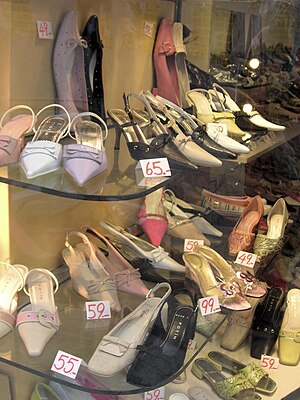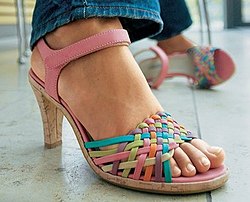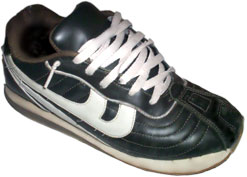Shoe
A shoe is an item of footwear worn on the foot or feet of a human, dog, cat, horse, or doll. Shoes may vary from a simple flip-flop to a complex boot. Shoes may have high or low heels, although in western cultures, high heels are considered a woman's style. Shoe materials include leather or canvas. Athletic shoe soles may be made of rubber.

Parts of a shoe
Sole
The bottom of a shoe is named the sole.
Insole
The insole is the interior bottom of a shoe, which sits directly beneath the foot. Many shoes have removable and replaceable insoles, and extra insoles are often added for comfort or health reasons (to control the shape, moisture, or smell of the shoe).
Outsole
The outsole is the layer in direct contact with the ground. The material of the outsole depends on the function, dressiness, and quality of the shoe, but is generally very durable material, since it experiences the most stress. Dress shoes have leather outsoles; casual or work-oriented shoes have outsoles made of natural rubber or a synthetic imitation. The outsole may comprise a single piece, or may comprise separate pieces of different materials. Often the heel of the sole is rubber for durability and traction, while the front is leather for style. Specialized shoes will often have modifications on this design: athletic cleats have spikes embedded in the outsole to grip the ground; many kinds of dancing shoes have much softer or harder soles. These soles can be as hard as concrete, and very sterdy.
Heel
The bottom rear part of a shoe is the heel. These come in a variety of sizes and are usually made to support the large stresses applied to the heel of the foot. They are often made of the same material as the sole of the shoe.This part can be high to make the person look taller, or flat.
Vamp, or upper
Any shoe has an upper part that helps hold the shoe onto the foot. In the simplest cases, such as sandals or flip flops, this may be nothing more than a few straps for holding the sole in place. Closed footwear, such as boots, sneakers and most men's shoes, will usually have a more complex upper. This part is normally decorated or is made in a certain style to look fashionable and attractive for the buyer.
Accessories to shoes
- shoe horn - can be used to insert a foot into a shoe by keeping the shoe open and providing a smooth surface for the foot to slide upon.
- shoe tree - placed inside the shoe when user is not wearing it, to help maintain the shoe's shape
- shoe polishing equipment
- shoe polish - a material spread on shoes to improve appearance, glossiness, and provide protection
- polishing cloth - a piece of fabric used to apply polish to the shoe
- overshoes - a rubber covering placed over shoes for rain and snow protection
- (orthopedic) shoe insert - insert of various materials for cushioning, improved fitt, or reduced abrasion. These include padding and inner linings. Inserts may also be used to correct foot problems
- shoe bag - a bag that protects the shoes against damage when they are not being worn
- shoe stretcher - a tool for making a shoe longer or wider or for reducing discomfort in areas of a shoe.
Purpose of shoes
Shoes fall into one of the following categories: dress, casual, work, snow, athletic, comfort and boots.
Dress and casual shoes
Dress shoes are categorized by smooth and supple leather uppers, leather soles, and narrow sleek shape. Casual shoes are characterized by sturdy leather uppers, non-leather outsoles, and wide profile.
Some designs of dress shoes can be worn by either gender. The majority of dress shoes have an upper covering, commonly made of leather, enclosing most of the lower foot, but not covering the ankles. This upper part of the shoe is often made without apertures or openings, but may also be made with openings or even itself consist of a series of straps, e.g. an open toe featured in women's shoes. Shoes with uppers made high to cover the ankles are also available; a shoe with the upper rising above the ankle is usually considered a boot but certain styles may be referred to as high-topped shoes or high-tops. Usually, a high-topped shoe is secured by laces or zippers, although some styles have elastic inserts to ease slipping the shoe on.

Men's shoes
Men's shoes can be categorized by how they are closed:
- Balmorals - the vamp has a V-shaped slit to which the laces are attached; also known as "closed lacing." In England, the balmoral is known as the Oxford. The word "Oxford" is used by American clothing companies to market shoes that are not Oxfords, such as rubber-sole bluchers.
- Blüchers - the laces are tied to two pieces of leather independently attached to the vamp; also known as "open lacing." In England, the Blucher is known as the Derby shoe.
- Monk-straps - a buckle and strap instead of lacing
Various other closings exist but are less popular such as side-elastic closings.
Men's shoes can also be decorated in various ways:
- Plain-toes - have a sleek appearance and no extra decorations on the vamp.
- Cap-toes - has an extra layer of leather that 'caps' the toe. This is possibly the most popular decoration
- Wing-tips - The toe of the shoe is covered with a perforated panel, the wing-tip, which extends down either side of the shoe. Wing-tips can be found in both balmoral and blucher styles. In England this is called a brogue.
Women's shoes
You must add a |reason= parameter to this Cleanup template – replace it with {{Cleanup|section|reason=<Fill reason here>}}, or remove the Cleanup template.
This article's tone or style may not reflect the encyclopedic tone used on Wikipedia. |

There is a large variety of shoes available for women. Some broad categories are:
Pumps, known in the US as ballerinas or skimmers, are shoes with a very low heel and a relatively short vamp, exposing much of the instep. They are popular for warm-weather wear, and may be seen as more comfortable than shoes with a higher heel.
High heels may be shoes with heels 2 inches (5 cm) or higher. They are often seen as having more sex appeal than low heels (see article for discussion) and are thus commonly worn by women for formal occasions or social outings.
Sandals are shoes that use a system of straps to secure the sole to the foot, leaving much of the foot exposed to air. They are thus popular for warm-weather wear, because they let the foot be cooler than a closed-toed shoe would.
Either gender

- Clog
- Platform shoe - shoe with very thick soles and heels
- Moccasin - originated by American Indians, a soft shoe without a heel and usually made of leather.
- Sandals - open shoes consisting of a sole and various straps
- Saddle shoe - leather shoe with a contrasting saddle-shaped band over the instep, typically white uppers with black "saddle"
- Loafer - a dress or casual shoe without laces; often with tassels, buckles, or coin-holders (penny loafers)
Boots - Long Shoes
Athletic Shoes

Men's and women's athletic shoes and special function shoes often have less difference between the sexes than in dress shoes. In many cases these shoes can be worn by either sex. Emphasis tends to be more on function than style.
- sneakers/trainers (also called gym shoes or tennis shoes) - general purpose athletic shoes; made out of rubber, cloth, and/or plastic to be lightweight, flexible, and have good traction. Special varieties available for basketball or tennis.
- running shoes - very similar to above, with additional emphasis on cushioning.
- boating shoes - also similar to above. They have soft soles/heels to avoid marring or scratching a boat deck.
- track shoes - lightweight; often with plastic or metal cleats
- cleats - a type of shoe featuring molded or removable studs. Usually worn while playing sports such as rugby, football, American football, or baseball
- golf shoes - with "spikes" for better grip in grass and wet ground. Originally the spikes or "cleats" were made of metal but replacable "soft spikes" made of synthetic plastic-like materials with prongs distributed radially around the edge of each spike are much more common today (and are required on many golf courses since they cause less damage to the greens)
- bowling shoes - intermediate style between ordinary dress shoes and athletic shoes. They have harder rubber soles/heels so as not to damage bowling alley floors. They are often rented or loaned at bowling alleys.
- hiking shoes or boots - usually have a high somewhat stiff upper with many lace eyelets, to provide ankle support on uneven terrain, with extra large traction on the sole.
- walking shoes - have a more flexible sole than the running shoe, lighter in weight than the hiking boot, may have air holes, may not be water proof.
- climbing shoes
- orthopedic shoes - specially designed for people with foot problems.
- skating shoes - typically called skates. They have various attachments for skating on the bottom of the shoe portion.
- ice skates
- roller skates
- inline skates
- ski boot - a large, thick plastic boot specially designed for attachment to the ski.
- skateboarding shoes- used for skateboarding but also worn by teenagers for fashion
- cycling shoes are equipped with a metal cleat to interface with clipless pedals, as well as a stiff sole to maximize power transfer and support the foot.
- sneaker boot and sneaker pump - a shoe that looks like an athletic shoe, but is equipped with a heel, making it a kind of novelty dress shoe
- Skateboarding Shoes have flat soles for a better grip on a skateboard. They are very wide and have extra layers of padding to protect the skateboarders feet. A lot of people wear them for comfort because of their width and soft padding.
Comfort Shoes
Shoes that are made with pedorthic and anatomically-correct comfort qualities such as padded removable footbeds, wide toe boxes and arch support are made especially for those with problematic feet.
Categories
- shoes are any type of footwear worn on the foot, and to prevent further argument, shoes include slippers, any type of heel shoes, uggs, and anything else you wear on your foot (not socks, unless the socks are really thick and shoe-like)
Dance shoes
- pointe shoes - shoes designed for ballet dancing, which have the toe box stiffened with glue so the dancer can rise on the tips of her (or his) toes
- ballet slipper - heel-less slippers made of canvas or leather, with usually a leather sole that may be continuous or in two parts (split-sole) - stiffer leather sole over the ball of the foot and over the heel, with the part of the shoe under the arch made of the softer material of the upper, so as the foot can be pointed to its utmost. Ballet slippers are usually secured by elastic straps. They are most commonly pink, white, black, or pale tan, although they may be made in specialty colours such as red oor blue.
- jazz shoe - similar in basic structure to a split-sole ballet slipper, jazz shoes usually have a longer vamp, securing the foot by laces or elastic inserts. Unlike ballet slippers, jazz shoes usually have a low (1" or under) heel.
- tango/flamenco dance shoes
- dance sneakers (or dansneakers)- a combination of a sneaker and a dance shoe, with a block toe like a ballet slipper
- character shoes - shoes with a 1"-3" heel, which are usually made of leather, and often have one or more straps across the instep to secure the foot during dance. They may come in soft-soled (suede) or hard-soled varieties. They may be adapted into tap shoes by attaching taps.
Work shoes
Work shoes are designed to stand heavy wear, to protect the wearer, and provide high traction. They are generally made from sturdy leather uppers and non-leather outsoles. Sometimes they are used for uniforms or comfort by nurses, waitresses, police, military personnel, etc. They are commonly used for protection in industrial settings, construction, mining, and other workplaces. Protective features may include steel-tipped toes and soles or ankle guards.
Snow shoes
Snowshoes are special shoes for walking in thick snow. In temperate climates, snowshoes are used for mostly recreational purposes in winter.
Boots
Boots are special shoes that are used in times of bad weather, or simply as an alternate style of casual or dress wear. Styles include rubber boots and snow boots, as well as work boots and hiking boots.
Historical Shoes
Footwear has been worn for tens of thousands of years. Shoes worn in the past include:
- Espadrilles: these sandals, which are still worn today, are found as early as the 14th century.
- Patten (shoe) | Patten]]: a European wooden overshoe used to keep a person's feet dry outdoors. First worn in the middle ages, they continued in use even into the early 20th century.
- Poulaine: a shoe with a long-pointed toe, popular in Europe in the 1400s.
Maintenance

- Breaking-in - Some shoes are made of hard but deformable material. After a person wears them multiple times, the material reforms to fit the wearer's feet. The person is said to have broken in the shoes.
- Polishing - for protection, water resistance (to some extent) and appearance, especially for leather shoes and boots.
- Heel replacement - heels periodically wear out. Not all shoes are designed to enable this.
- Sole replacement - soles also wear out. Not all shoes can have their soles replaced.
- Shoelace replacement.
- When unfit for use, shoes can be treated as trash or municipal solid waste and disposed of. The exception can be with most athletic sneakers which can be recycled and turned into other raw materials. See Nike Grind as an example.
Someone who makes or repairs shoes in a shop is called a cobbler.
Shoe etiquette
In most parts of the world (Asia, Eastern Europe, parts of the Middle East and Africa, much of Northern Europe and Canada, as well as Alaska) it is customary to remove shoes when entering a house. In some areas of the United States, especially the Midwest, it is expected that visitors remove their shoes unless a host specifically invites them to leave their shoes on. People do this to avoid bringing dirt, mud or snow into the house. For some societies, including those in Asia, indoor footwear may be provided for guests.
In the Middle East, parts of Africa, Korea and Thailand, it is considered rude to show the soles of the feet to others (even accidentally, such as by crossing the legs). In addition, in Thailand, it is an extreme insult for the foot, socks, or shoes to touch someone's head or be placed over it. Although feet touching heads is an extremely rare occurrence in any society, some Muay Thai boxers insult each other by "kicking" the opponent's head with their foot (most Muay Thai kicks are executed with the shin).
See also dress code.
Shoes in Literature
Shoes play an important role on the fairy tales Cinderella and The Red Shoes. In literature and film, an empty shoe or a pair of shoes signifies death.[citation needed]
Sizes
- Units for shoe sizes vary widely around the world. European sizes are measured in Paris Points, which are worth two-thirds of a centimetre. The UK and American units are approximately one-quarter of an inch, starting at 8¼ inches. Men's and women's shoe sizes often have different scales. Shoes size is often measured using a Brannock Device, which can determine both the width and length of the foot.
Shoe companies
See the category shoe companies for a list of shoe companies.
References
Further reading
- History of footwear in Norway, Sweden and Finland : prehistory to 1950, ISBN 91-7402-323-3
- Patrick Cox: Wit, Irony, and Footwear, Tamasin Doe (1998) ISBN 0-8230-1148-8
- Shoes : A Celebration of Pumps, Sandals, Slippers & More, ISBN 0-7611-0114-4
- A Century of Shoes: Icons of Style in the 20th Century, Angela Pattison ISBN 0-7858-0835-3
- Shoes , Elizabeth Cotton (1999) ISBN 1-55670-894-7
- Shoes : A Lexicon of Style, Valerie Steel ISBN 0-8478-2166-8
- Mad About Shoes, Emma Bowd ISBN 1-84172-353-3
- Bootism : A Shoe Religion, Penina Goodman, Michael Duranko (2003) ISBN 0-7407-3832-1
- The Perfect Fit: What Your Shoes Say about You, Meghan Cleary, Sydney Van Dyke ISBN 0-8118-4501-X
See also
External links
- Footwear History
- International Shoe Size Conversion Charts, from i18nguy's website, offers more information.
- Shoe Care
- The History of Footwear, includes diagrams of parts
- The Political History of Shoes
- ShoeGuide.Org, A footwear encyclopedia
- Reviews of Golf Shoes
- The Shoes You Wear
